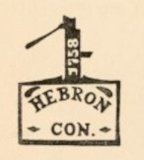
The Hebron Historical Society
Hebron, Connecticut
Enjoy Hebron - It's Here To Stay ™

This January marks the 150th anniversary of the Emancipation Proclamation in 1863. To note and celebrate Hebron's important role in the abolition of slavery, the Hebron Historical Society has created a new section, "Hebron & Slavery" on its website. The new section gathers together dozens of documents chronicling Hebron's rich tradition of opposing slavery and supporting human rights. The reader will find enough information with which to write a term paper!
Early citizens of Hebron made statements and took strong action against slavery long before 1863. Hebron was ahead of Prudence Crandall's Canterbury school by nearly 50 years, and promoted abolition 75 years before Harriet Beecher Stowe's "Uncle Tom's Cabin" was printed. In 2007, Hebron was selected as a site on the Connecticut Freedom Trail, a tribute to our town's citizenry and their great respect for all neighbors, regardless of color or status.
Abduction of the Cesar and Lowis Peters Family
Many have heard about the 1787 abduction of Hebron slaves, Cesar and Lowis Peters, along with their 8 children. Their owner was the Rev. Samuel Peters, a minister of the Anglican Church on Godfrey Hill, Hebron. Due to the Reverend's Loyalist sympathy and sermons to his parishioners, he was threatened with "tarring and feathering" by the town fathers. Rev. Peters fled to England in 1774, leaving his family & slaves to fend for themselves.
In 1787 Rev. Peters was still in England, although he had accrued liability in Hebron, so the men designated by Rev. Peters with power-of-attorney, John and Nathaniel Mann, were attempting to straighten out their relative's financial mess. To pay a debt, Nathaniel Mann arranged to have Cesar and Lowis sold to a South Carolina slave owner. The attempt of one David Prior to retrieve his new slaves is the story of an attempted abduction and the response of Hebron's citizenry to prevent it.
A little chicanery by Hebron's judicial and law enforcement officials stopped Mr. Prior at the dock in Norwich, just prior to loading his "property" and heading south. Not only did Hebron's officials save their friends from an uncertain future, but worked with the state to have Cesar and Lowis emancipated within two years. Various depositions show that Rev. Peters never wanted to do anything but free Cesar and Lowis.
Even after the quick action by Hebron citizens to save the Cesar & Lowis Peters family from being sent to South Carolina, some of Hebron's wealthier landowners continued to hold slaves. The Federal Census of 1790 lists 15 slaves still owned in Hebron -- among the owners, some who fought for the freedom of Cesar and Lowis! By 1848, the State of Connecticut had abolished slavery within its boundaries.
Josephine Sophia (White) Griffing
Not as well known, but equally as important is the abolitionist and freedmen's work of Hebron's daughter, Josephine Sophia (White) Griffing. She was born December 18, 1814 to Joseph and Sophia (Waldo) White, and was a descendant of Peregrine White, first white child born in New England in the Mayflower. Josephine received her early education in the Burrows Hill School and completed her studies at Bacon Academy. In 1842, several years after her marriage to Charles S. Griffing, the couple moved to Ohio.
It was in Ohio that Josephine Griffing's reform work began. Among her acquaintances were: Abraham Lincoln, William Lloyd Garrison, Edwin L. Stanton, and others. Her home was a station on the Underground Railroad, a respite for runaway slaves. She was part of the abolitionist speaking circuit, an unusual deed for a woman, and she received much favorable attention.
Probably the largest contribution of Mrs. Griffing was her work in recognizing and protecting those who had recently been released from slavery. Following their emancipation, the ex-slaves were quite lost when it came to making their own living and caring for their families. Many ended up in camps, still without direction or wherewithal. After the birth of the Freedmen's Bureau, many of our politicians simply lost interest in the cause. The Freedmen's Bureau worked as both "conscience and common-sense of the country". It was here that Josephine aggressively approached government leaders to gain support for our newly freed citizens.
Josephine died in 1872, and is buried with many of her relatives in
Hebron's Burrows Hill Cemetery. Her gravestone reads: "A friend to the slave, The poor and oppressed. With unswerving faith in God's eternal justice. Her life was given in their service."
For More Information
To read the full stories of both the Cesar Peters family and Josephine Griifing, go to the website of the Hebron Historical Society (HHS) at http://www.hebronhistoricalsociety.org and click on Hebron & Slavery. The site includes dozens of original documents, as well as the movie, "Testimonies of a Quiet New England Town," produced by HHS.
To read about Hebron's placement on the Connecticut Freedom Trail, see http://www.ctfreedomtrail.org/.
To study Yale University's "Citizens All: African Americans in Connecticut, 1700-1850", go to http://cmi2.yale.edu/citizens_all/stories/index.html. The Cesar and Lowis Peters story is found in the "Freedom" chapter.
Mary Ann Foote, Hebron Historian
January 2013